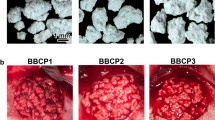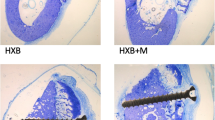Abstract
Objectives
The preclinical study aimed to establish a standardized preclinical model to investigate osseous graft consolidation in defect configurations of limited regenerative capacity.
Material and methods
Critical size defects (CSD) were prepared and titanium tubes inserted for defect separation from local bone in the forehead area of 18 pigs. Defects were filled with demineralized bovine bone mineral (DBBM) or served as empty controls and were covered with a resorbable collagen membrane (CM) or left untreated. Six randomly selected pigs were sacrificed after 4, 8 and 12 weeks. Specimens were histologically and histomorphometrically analysed focusing on newly formed bone (NFB), demineralized bovine bone mineral (DBBM) and soft tissue (ST) proportions.
Results
Four weeks after defect preparation, no statistically significant difference concerning NFB quantity could be detected within the groups. Defects covered with the CM showed lower amounts of DBBM. After 6 and 12 weeks, defects augmented with DBBM in combination with a CM (8 weeks: 43.12 ± 4.31; 12 weeks: 43.05 ± 3.01) showed a statistically significant higher NFB rate compared to empty control defects covered with 8 weeks: 7.66 ± 0.59; 12 weeks or without a CM; 8 weeks: 8.62 ± 2.66; 12 weeks: 18.40 ± 2.40. CM application showed no significant impact on osseous defect regeneration or soft tissue formation. Superior NFB could be detected for basal aspect for several evaluation time points.
Conclusions
The modification of CSD with titanium tubes represents a suitable model to imitate a one-wall defect regeneration situation.
Clinical relevance
The established model represents a promising method to evaluate graft consolidation in one-wall defect configuration.






Similar content being viewed by others
References
Esposito M, Grusovin MG, Felice P, Karatzopoulos G, Worthington HV, Coulthard P (2009) Interventions for replacing missing teeth: horizontal and vertical bone augmentation techniques for dental implant treatment. Cochrane Database Syst Rev 4:CD003607. https://doi.org/10.1002/14651858.CD003607.pub4
Esposito M, Grusovin MG, Kwan S, Worthington HV, Coulthard P (2008) Interventions for replacing missing teeth: bone augmentation techniques for dental implant treatment. Cochrane Database Syst Rev 3:CD003607. https://doi.org/10.1002/14651858.CD003607.pub3
Rogers GF, Greene AK (2012) Autogenous bone graft: basic science and clinical implications. J Craniofac Surg 23(1):323–327. https://doi.org/10.1097/SCS.0b013e318241dcba
Nkenke E, Schultze-Mosgau S, Radespiel-Troger M, Kloss F, Neukam FW (2001) Morbidity of harvesting of chin grafts: a prospective study. Clin Oral Implants Res 12(5):495–502
Schlegel KA, Lang FJ, Donath K, Kulow JT, Wiltfang J (2006) The monocortical critical size bone defect as an alternative experimental model in testing bone substitute materials. Oral Surg Oral Med Oral Pathol Oral Radiol Endod 102(1):7–13. https://doi.org/10.1016/j.tripleo.2005.09.011
Swindle MM, Smith AC, Hepburn BJ (1988) Swine as models in experimental surgery. J Investig Surg 1(1):65–79
Schlegel KA, Rupprecht S, Petrovic L, Honert C, Srour S, von Wilmowsky C, Felszegy E, Nkenke E, Lutz R (2009) Preclinical animal model for de novo bone formation in human maxillary sinus. Oral Surg Oral Med Oral Pathol Oral Radiol Endod 108(3):e37–e44. https://doi.org/10.1016/j.tripleo.2009.05.037
von Wilmowsky C, Moest T, Nkenke E, Stelzle F, Schlegel KA (2014) Implants in bone: part II. Research on implant osseointegration: material testing, mechanical testing, imaging and histoanalytical methods. Oral Maxillofac Surg 18(4):355–372. https://doi.org/10.1007/s10006-013-0397-2
Schmitz JP, Hollinger JO (1986) The critical size defect as an experimental model for craniomandibulofacial nonunions. Clin Orthop Relat Res (205):299–308
Sirola K (1960) Regeneration of defects in the calvaria. An experimental study. Ann Med Exp Biol Fenn 38(Suppl 2):1–87
Cortellini P, Tonetti MS (2000) Focus on intrabony defects: guided tissue regeneration. Periodontol 2000(22):104–132
Pagni G, Pellegrini G, Giannobile WV, Rasperini G (2012) Postextraction alveolar ridge preservation: biological basis and treatments. Int J Dent 2012(151030):1–13. https://doi.org/10.1155/2012/151030
Saghaei M (2004) Random allocation software for parallel group randomized trials. BMC Med Res Methodol 9(4):26
Donath K, Breuner G (1982) A method for the study of undecalcified bones and teeth with attached soft tissues. The sage-Schliff (sawing and grinding) technique. J Oral Pathol 11(4):318–326
Moest T, Wehrhan F, Lutz R, Schmitt CM, Neukam FW, Schlegel KA (2015) Extra-oral defect augmentation using autologous, bovine and equine bone blocks: a preclinical histomorphometrical comparative study. J Craniomaxillofac Surg 43(4):559–566. https://doi.org/10.1016/j.jcms.2015.02.012
Lutz R, Park J, Felszeghy E, Wiltfang J, Nkenke E, Schlegel KA (2008) Bone regeneration after topical BMP-2-gene delivery in circumferential peri-implant bone defects. Clin Oral Implants Res 19(6):590–599. https://doi.org/10.1111/j.1600-0501.2007.01526.x
Moest T, Koehler F, Prechtl C, Schmitt C, Watzek G, Schlegel KA (2014) Bone formation in peri-implant defects grafted with microparticles: a pilot animal experimental study. J Clin Periodontol 41(10):990–998. https://doi.org/10.1111/jcpe.12295
Stockmann P, Park J, von Wilmowsky C, Nkenke E, Felszeghy E, Dehner JF, Schmitt C, Tudor C, Schlegel KA (2012) Guided bone regeneration in pig calvarial bone defects using autologous mesenchymal stem/progenitor cells - a comparison of different tissue sources. J Craniomaxillofac Surg 40(4):310–320. https://doi.org/10.1016/j.jcms.2011.05.004
Tudor C, Srour S, Thorwarth M, Stockmann P, Neukam FW, Nkenke E, Schlegel KA, Felszeghy E (2008) Bone regeneration in osseous defects-application of particulated human and bovine materials. Oral Surg Oral Med Oral Pathol Oral Radiol Endod 105(4):430–436. https://doi.org/10.1016/j.tripleo.2007.07.037
Schlegel KA, Kloss FR, Kessler P, Schultze-Mosgau S, Nkenke E, Wiltfang J (2003) Bone conditioning to enhance implant osseointegration: an experimental study in pigs. Int J Oral Maxillofac Implants 18(4):505–511
Jensen J, Tvedesøe C, Rölfing JH, Foldager CB, Lysdahl H, Kraft DC, Chen M, Baas J, Le DQ, Bünger CE (2016) Dental pulp-derived stromal cells exhibit a higher osteogenic potency than bone marrow-derived stromal cells in vitro and in a porcine critical-size bone defect model. SICOT J 20(2):16. https://doi.org/10.1051/sicotj/2016004
Taga ML, Granjeiro JM, Cestari TM, Taga R (2008) Healing of critical-size cranial defects in Guinea pigs using a bovine bone-derived resorbable membrane. Int J Oral Maxillofac Implants 23(3):427–436
Eitel F, Seiler H, Schweiberer L (1981) Morphologic examination of animal-experiment results: comparison with regeneration of the human bone-structure. I. Research methods (author's transl). Unfallheilkunde 84(6):250–254
Reddi AH (1975) The matrix of rat calvarium as transformant of fibroblasts. Proc Soc Exp Biol Med 150(2):324–326
Hollinger JO, Kleinschmidt JC (1990) The critical size defect as an experimental model to test bone repair materials. J Craniofac Surg 1(1):60–68
Busenlechner D, Tangl S, Mair B, Fugger G, Gruber R, Redl H, Watzek G (2008) Simultaneous in vivo comparison of bone substitutes in a guided bone regeneration model. Biomaterials 29(22):3195–3200. https://doi.org/10.1016/j.biomaterials.2008.04.021
Zhu SJ, Choi BH, Huh JY, Jung JH, Kim BY, Lee SH (2006) A comparative qualitative histological analysis of tissue-engineered bone using bone marrow mesenchymal stem cells, alveolar bone cells, and periosteal cells. Oral Surg Oral Med Oral Pathol Oral Radiol Endod 101(2):164–169. https://doi.org/10.1016/j.tripleo.2005.04.006
Lutz R, Sendlbeck C, Wahabzada H, Tudor C, Prechtl C, Schlegel KA (2017) Periosteal elevation induces supracortical peri-implant bone formation. J Craniomaxillofac Surg 45(8):1170–1178. https://doi.org/10.1016/j.jcms.2017.05.009
Bauer TW, Muschler GF (2000) Bone graft materials. An overview of the basic science. Clin Orthop Relat Res 371(371):10–27
Rothamel D, Schwarz F, Herten M, Ferrari D, Mischkowski RA, Sager M, Becker J (2009) Vertical ridge augmentation using xenogenous bone blocks: a histomorphometric study in dogs. Int J Oral Maxillofac Implants 24(2):243–250
Araujo MG, Liljenberg B, Lindhe J (2010) Dynamics of bio-Oss collagen incorporation in fresh extraction wounds: an experimental study in the dog. Clin Oral Implants Res 21(1):55–64. https://doi.org/10.1111/j.1600-0501.2009.01854.x
Busenlechner D, Tangl S, Arnhart C, Redl H, Schuh C, Watzek G, Gruber R (2012) Resorption of deproteinized bovine bone mineral in a porcine calvaria augmentation model. Clin Oral Implants Res 23(1):95–99. https://doi.org/10.1111/j.1600-0501.2011.02198.x
Acknowledgements
The study was undertaken in cooperation with the Semmelweis-University, Budapest, Hungary. Animal care keeping and surgical procedures were performed in the laboratories of the Semmelweis-University, Budapest, Hungary. Specimen processing was done in the laboratories of the Department of Oral and Maxillofacial Surgery, University of Erlangen-Nürnberg, Erlangen, Germany. Geistlich Pharma AG, Wolhusen, Switzerland, supported this study. The authors have no conflicts of interest. The work of Dr. E. Felszeghy, A. Krautheim-Zenk and S. Schönherr is highly appreciated.
Funding
The work was supported by Geistlich Pharma AG, Wolhusen, Switzerland (KC 354-12036).
Author information
Authors and Affiliations
Corresponding author
Ethics declarations
Conflict of interest
Tobias Moest declares that he has no conflict of interest. Karl Andreas Schlegel declares that he has no conflict of interest. Marco Kesting declares that he has no conflict of interest. Matthias Fenner declares that he has no conflict of interest. Rainer Lutz declares that he has no conflict of interest. Daniele Machado Beck declares that she has no conflict of interest. Cornelius von Wilmowsky declares that he has no conflict of interest.
Ethical approval
The presented work was approved by the Pest county government department for food safety and animal health, Hungary (approval number: 1112/000/2003).
Informed consent
For this type of study, formal consent is not required.
Additional information
Publisher’s note
Springer Nature remains neutral with regard to jurisdictional claims in published maps and institutional affiliations.
Rights and permissions
About this article
Cite this article
Moest, T., Schlegel, K.A., Kesting, M. et al. A new standardized critical size bone defect model in the pig forehead for comparative testing of bone regeneration materials. Clin Oral Invest 24, 1651–1661 (2020). https://doi.org/10.1007/s00784-019-03020-w
Received:
Accepted:
Published:
Issue Date:
DOI: https://doi.org/10.1007/s00784-019-03020-w




